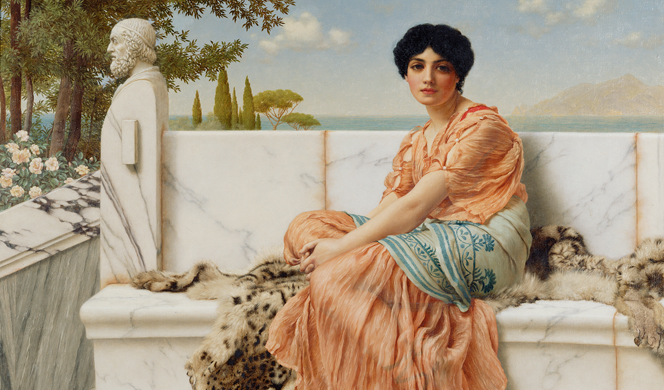
Similar to Emily Bronte, Sappho fascinates men and women from all over the world. Perhaps this is due to certain combinations that are very much present in the works of these two gifted artists: intelligence and passion, cheerfulness and despair, sensuality and spirituality. Such contrasts have a certain attraction and appeal. And, of course, much of the fascination is rooted in the aura of mystery that surrounds both women. But if Emily Bronte remains a rather enigmatic figure, Sappho is more so. All that is known about her with a fair degree of certainty is that she was a Greek poet and singer who lived on the island of Lesbos during the sixth century B.C. Virtually everything else that we have heard about her is a product of guesswork or imagination.
The book that I have read and re-read over the years is a translation by Mary Barnard (published in 1958). I have also made use of a volume from the Loeb Classical Library that has the Greek and English on facing pages. The latter version drives home the fact that Sappho’s literary remains are largely fragmentary (and that I am inept where the Greek language is concerned). On the other hand, the Mary Barnard translation is structured in a much more cohesive way. The result is a poetic masterpiece. This edition contains a hundred of Sappho’s poems, most of which are as brief and stark as the following:
‘Standing by my bed / In gold sandals / Dawn that very moment awoke me’.
The subject matter of her compositions is diverse. The one that is titled “Although clumsy” draws the attention of her friends to the little-noticed shapeliness of someone named Mnasidica. Or sometimes the poet addresses herself: ‘What, Sappho, can you give one who has everything, like Aphrodite?’ She expresses tender love for her daughter, Cleis, or she invokes a divine blessing upon someone else who is dear to her. Like a Greek variation of haiku, Sappho’s poetry is often rendered in the present-tense—as when she describes the noontime chirps of crickets, or girls dancing in the spring twilight, or the silvery light of a full moon. She sings about the joys and torments of love, or she sorrows over capricious friendships and the pain of loneliness. She can be vain and spiteful but also deeply philosophical:
‘We know this much / Death is an evil; we have the gods’ word for it; they too would die if death were a good thing’.
A reader could skim through the Barnard translation within an hour, but that would be the wrong way to experience these gems of antiquity. I would suggest listening to some classical Greek lyre music (available on YouTube) before or even during one’s reading of Sappho. In any case, the contents of this book should be absorbed in an attentive, sympathetic and leisurely manner.